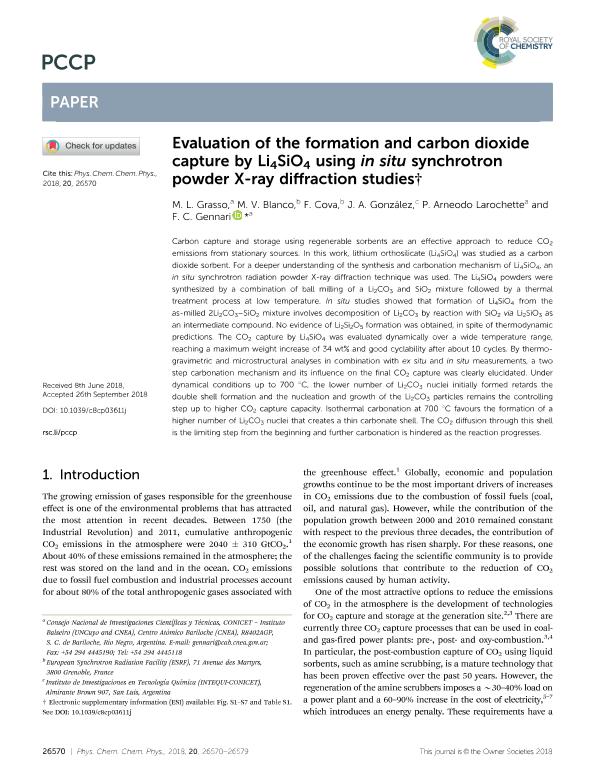Mostrar el registro sencillo del ítem
dc.contributor.author
Grasso, María Laura

dc.contributor.author
Blanco, M. V.
dc.contributor.author
Cova, F.
dc.contributor.author
Gonzalez, Jorge Alberto

dc.contributor.author
Arneodo Larochette, Pierre Paul

dc.contributor.author
Gennari, Fabiana Cristina

dc.date.available
2021-02-09T02:45:20Z
dc.date.issued
2018-09-26
dc.identifier.citation
Grasso, María Laura; Blanco, M. V.; Cova, F.; Gonzalez, Jorge Alberto; Arneodo Larochette, Pierre Paul; et al.; Evaluation of the formation and carbon dioxide capture by Li4SiO4 using: In situ synchrotron powder X-ray diffraction studies; Royal Society of Chemistry; Physical Chemistry Chemical Physics; 20; 41; 26-9-2018; 26570-26579
dc.identifier.issn
1463-9076
dc.identifier.uri
http://hdl.handle.net/11336/125155
dc.description.abstract
Carbon capture and storage using regenerable sorbents are an effective approach to reduce CO2 emissions from stationary sources. In this work, lithium orthosilicate (Li4SiO4) was studied as a carbon dioxide sorbent. For a deeper understanding of the synthesis and carbonation mechanism of Li4SiO4, an in situ synchrotron radiation powder X-ray diffraction technique was used. The Li4SiO4 powders were synthesized by a combination of ball milling of a Li2CO3 and SiO2 mixture followed by a thermal treatment process at low temperature. In situ studies showed that formation of Li4SiO4 from the as-milled 2Li2CO3–SiO2 mixture involves decomposition of Li2CO3 by reaction with SiO2via Li2SiO3 as an intermediate compound. No evidence of Li2Si2O5 formation was obtained, in spite of thermodynamic predictions. The CO2 capture by Li4SiO4 was evaluated dynamically over a wide temperature range, reaching a maximum weight increase of 34 wt% and good cyclability after about 10 cycles. By thermogravimetric and microstructural analyses in combination with ex situ and in situ measurements, a two step carbonation mechanism and its influence on the final CO2 capture was clearly elucidated. Under dynamical conditions up to 700 °C, the lower number of Li2CO3 nuclei initially formed retards the double shell formation and the nucleation and growth of the Li2CO3 particles remains the controlling step up to higher CO2 capture capacity. Isothermal carbonation at 700 °C favours the formation of a higher number of Li2CO3 nuclei that creates a thin carbonate shell. The CO2 diffusion through this shell is the limiting step from the beginning and further carbonation is hindered as the reaction progresses.
dc.format
application/pdf
dc.language.iso
eng
dc.publisher
Royal Society of Chemistry

dc.rights
info:eu-repo/semantics/openAccess
dc.rights.uri
https://creativecommons.org/licenses/by-nc-sa/2.5/ar/
dc.subject
SYNCHROTRON
dc.subject
CARBON DIOXIDE
dc.subject
CAPTURE
dc.subject.classification
Química Inorgánica y Nuclear

dc.subject.classification
Ciencias Químicas

dc.subject.classification
CIENCIAS NATURALES Y EXACTAS

dc.title
Evaluation of the formation and carbon dioxide capture by Li4SiO4 using: In situ synchrotron powder X-ray diffraction studies
dc.type
info:eu-repo/semantics/article
dc.type
info:ar-repo/semantics/artículo
dc.type
info:eu-repo/semantics/publishedVersion
dc.date.updated
2020-11-24T14:04:36Z
dc.identifier.eissn
1463-9084
dc.journal.volume
20
dc.journal.number
41
dc.journal.pagination
26570-26579
dc.journal.pais
Reino Unido

dc.journal.ciudad
Cambridge
dc.description.fil
Fil: Grasso, María Laura. Comisión Nacional de Energía Atómica. Centro Atómico Bariloche; Argentina. Comisión Nacional de Energía Atómica. Gerencia del Área de Energía Nuclear. Instituto Balseiro; Argentina. Consejo Nacional de Investigaciones Científicas y Técnicas. Centro Científico Tecnológico Conicet - Patagonia Norte; Argentina
dc.description.fil
Fil: Blanco, M. V.. European Synchrotron Radiation; Francia
dc.description.fil
Fil: Cova, F.. European Synchrotron Radiation; Francia
dc.description.fil
Fil: Gonzalez, Jorge Alberto. Consejo Nacional de Investigaciones Científicas y Técnicas. Centro Científico Tecnológico Conicet - San Luis. Instituto de Investigaciones en Tecnología Química. Universidad Nacional de San Luis. Facultad de Química, Bioquímica y Farmacia. Instituto de Investigaciones en Tecnología Química; Argentina
dc.description.fil
Fil: Arneodo Larochette, Pierre Paul. Comisión Nacional de Energía Atómica. Centro Atómico Bariloche; Argentina. Comisión Nacional de Energía Atómica. Gerencia del Área de Energía Nuclear. Instituto Balseiro; Argentina. Consejo Nacional de Investigaciones Científicas y Técnicas. Centro Científico Tecnológico Conicet - Patagonia Norte; Argentina
dc.description.fil
Fil: Gennari, Fabiana Cristina. Comisión Nacional de Energía Atómica. Centro Atómico Bariloche; Argentina. Comisión Nacional de Energía Atómica. Gerencia del Área de Energía Nuclear. Instituto Balseiro; Argentina. Consejo Nacional de Investigaciones Científicas y Técnicas. Centro Científico Tecnológico Conicet - Patagonia Norte; Argentina
dc.journal.title
Physical Chemistry Chemical Physics

dc.relation.alternativeid
info:eu-repo/semantics/altIdentifier/url/http://xlink.rsc.org/?DOI=C8CP03611J
dc.relation.alternativeid
info:eu-repo/semantics/altIdentifier/doi/https://doi.org/10.1039/C8CP03611J
Archivos asociados
